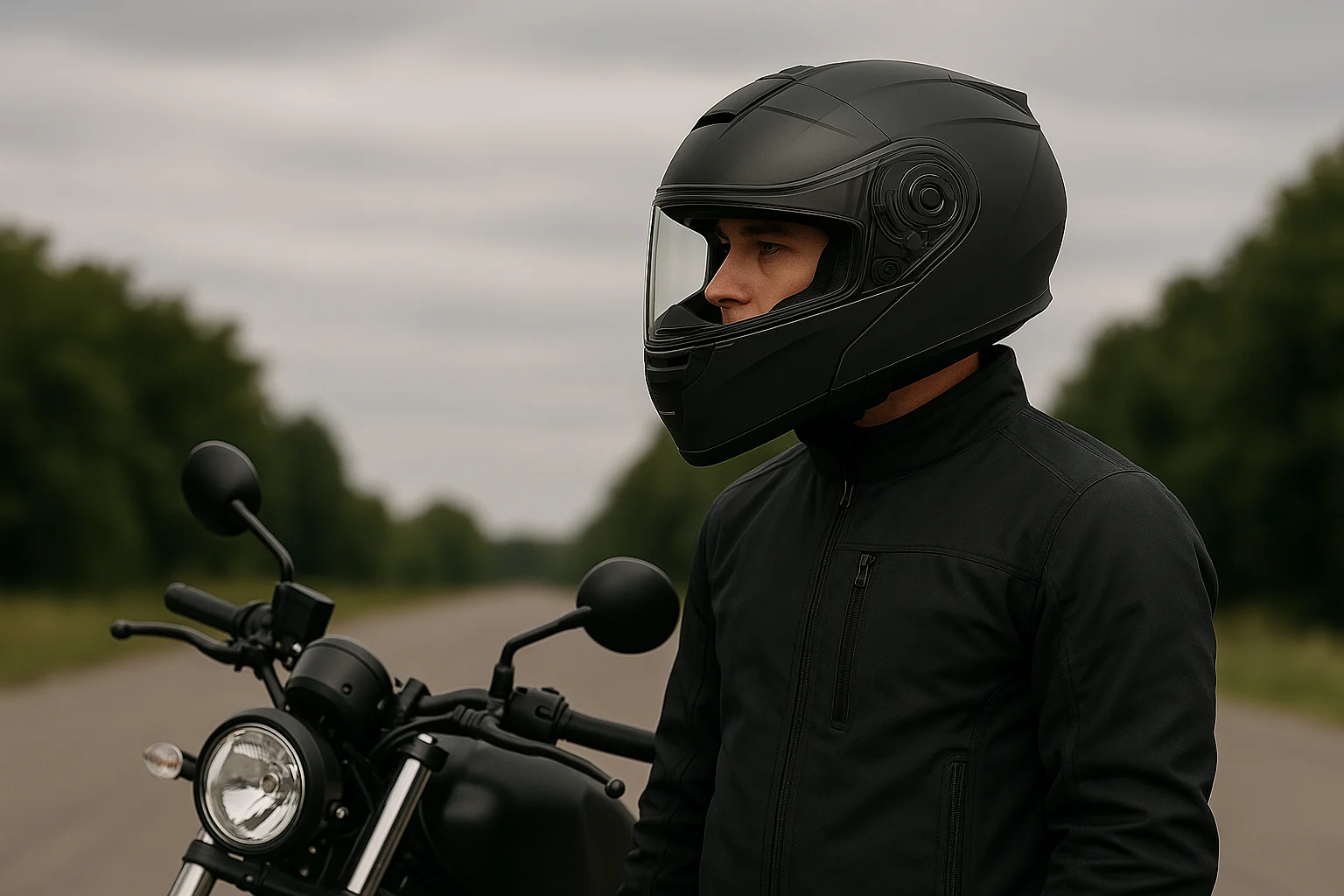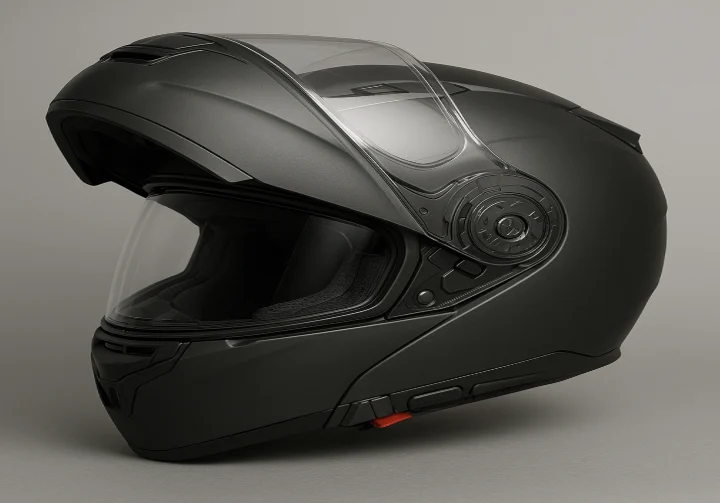If you’re like me and have spent hours looking at different motorcycle helmets online or at a gear shop, then chances are you’ve come across the term modular helmet. So, what is a modular motorcycle helmet?
At first, it sounded technical and complicated. But when I started touring more frequently and needed something practical, I gave modular helmets a closer look. Now that I’ve been riding with one for a while, I want to share everything I learned about what a modular motorcycle helmet really is, how it works, and why it might be a perfect fit for riders like you and me.
This blog is not written from a tech manual or product brochure. It’s written from personal experience, and I’ll explain it in plain English. So, let’s break it down step by step.
What Is a Modular Helmet?
A modular motorcycle helmet is like a hybrid between a full face helmet and an open face helmet. When the chin guard is closed, it looks just like a full face helmet, offering full coverage from the top of your head down to your chin. But the big difference is that you can lift the front part (the chin bar and visor) upwards with the press of a button.
Some people also call it a flip-up helmet, convertible helmet, or flip face helmet. Whatever name you use, the idea is the same: it gives you the protection of a full face helmet with the convenience of an open face design.
When I first switched to a modular helmet, I was surprised how much easier it made everyday riding tasks. Talking to someone at a fuel station, grabbing a drink without taking off the helmet, or adjusting my glasses mid-ride, all became possible without unstrapping anything.
Why I Chose a Modular Helmet
Before I started using one, I was riding with a standard full face helmet. It was safe, sure. But every time I needed to talk to someone or take a sip of water, I had to take the whole thing off. If you ride with glasses, you know how annoying this can be.

That’s when I started looking into modular helmets, and after testing a few, I found one with P/J certification (I’ll explain what that means shortly). Since then, it’s become my go-to for every ride, from quick city commutes to long highway tours.
How a Modular Helmet Works
Here’s the simple breakdown.
- Chin bar flips up: You press a button, and the entire front face of the helmet lifts up.
- Works like two helmets in one: Closed, it gives you full protection. Open, it acts more like a three-quarter or jet-style helmet.
- You still wear it with a chin strap: Even with the face flipped up, it remains securely on your head.
This flip-up feature might seem small, but it’s a game-changer in real riding scenarios. You can talk, breathe easier in traffic, sip water, and avoid constantly removing your helmet for small tasks.
Safety of Modular Helmets: Are They Reliable?
This was my biggest concern too, is it as safe as a full face helmet?
The short answer is yes, if you choose the right model. The long answer depends on something called helmet certification.
When shopping, check the label under the helmet strap. You’ll find one of the following codes:
- P = Protective (full face certified)
- J = Jet (open face certified)
- P/J = Certified for both full face and open face use
My helmet has P/J certification, which means it was tested for safety both with the chin guard closed and open. That gave me peace of mind knowing it wasn’t just a fancy convenience feature but also reliable protection.
Curious about the deeper safety details? Are modular helmets safe goes into all the official certifications and test standards you should know.
Modular Helmet Features That Made My Life Easier
Once I started using one, I noticed some small things that made a big difference.
1. Perfect for City Traffic
On hot days or in traffic jams, flipping the chin bar up gave me fresh air without removing my helmet. It’s a lifesaver when you’re stuck in slow-moving traffic and need to cool down a bit.
2. Easy Communication
Talking to people at checkpoints, toll booths, or just chatting with fellow riders during stops became super easy. I just flip the front up and talk, no shouting, no muffled voice.
3. Better for Glasses Wearers
If you wear glasses like I do, you know the pain of stuffing your head into a tight full face helmet and pulling your frames off in the process. Modular helmets solve this, you can put your glasses on after the helmet is in place. No stress at all.
Some Things to Watch Out For
Like all gear, modular helmets aren’t perfect. Here’s what I noticed:
- Heavier than full face helmets: The flip mechanism adds some weight. You might feel it on longer rides.
- More wind noise: Not all modular helmets are as quiet as full face ones. It depends on the design and fit.
- Safety when flipped up: Only P/J approved helmets are safe to ride with the chin bar up. And even then, it’s better to ride slower when it’s open.
You should never ride at high speeds with the chin bar up unless the helmet is specifically designed for it and certified.
What Is the Difference Between Modular and Full Face Helmets?
To put it in simple terms:
| Feature | Modular Helmet | Full Face Helmet |
| Chin Bar | Flip-up | Fixed |
| Weight | Slightly heavier | Lighter |
| Airflow | Better when chin up | Less airflow |
| Convenience | High (talk, drink, wear glasses) | Low |
| Safety | Great (with P/J certification) | Excellent |
| Versatility | Works for both city and highway | Best for highway and racing |
If you’re wondering whether to switch or stick with your current helmet, it really depends on how and where you ride.
Bonus Tip: Locking Your Helmet Safely
One thing I learned the hard way, modular helmets are expensive, and if you leave yours sitting on the seat or handlebars, someone might just walk off with it.
Now I always use a secure method to lock it when I leave my bike parked. If you’re not sure how to do that, check out this helpful guide on how to lock motorcycle helmet to bike for safe and simple solutions.
Adding Tech: My Audio Setup
As someone who rides longer routes on weekends, I love listening to music or GPS navigation. I recently added audio to my modular helmet using CHIPS wireless setup. The whole process was super easy, and it made my rides a lot more fun.
If you’re looking to add audio too, you can follow this detailed guide: how to add audio to CHIPS wireless helmet. It’s beginner-friendly and doesn’t require any fancy tools.
What I’d Recommend to a New Rider
If you’re new to motorcycling or upgrading your first helmet, here’s what I’d say from experience:
- Look for P/J certified modular helmets, they give you the most flexibility without compromising safety.
- Make sure the fit is right. A helmet should feel snug but not too tight.
- Try flipping the chin bar up and down a few times before buying to see how smooth it is.
- Don’t go cheap on safety gear. Your helmet is the one thing that protects your head, so make it count.
If you’re curious about whether your car helmet is enough, this comparison between car helmet vs motorcycle helmet will explain why the two are not the same.
Is a Modular Helmet Right for You?
A modular motorcycle helmet changed the way I ride. For someone like me who enjoys both city rides and weekend tours, it gave me freedom, comfort, and confidence.
It’s not just about convenience, it’s about making the whole riding experience more practical. Whether you’re chatting at a stoplight, adjusting your glasses, or catching your breath in the heat, that flip-up feature starts to feel less like a luxury and more like a necessity.
If you value flexibility, ride in mixed environments, and wear glasses or love easy conversations, I’d absolutely say yes, go for a modular helmet. Just make sure it’s P/J certified, fits well, and comes from a trusted brand. Hope so, now you know what is a modular motorcycle helmet?
Riding is already a joy. The right helmet just makes it smoother, safer, and more fun.
Stay safe, ride smart, and gear up right.





